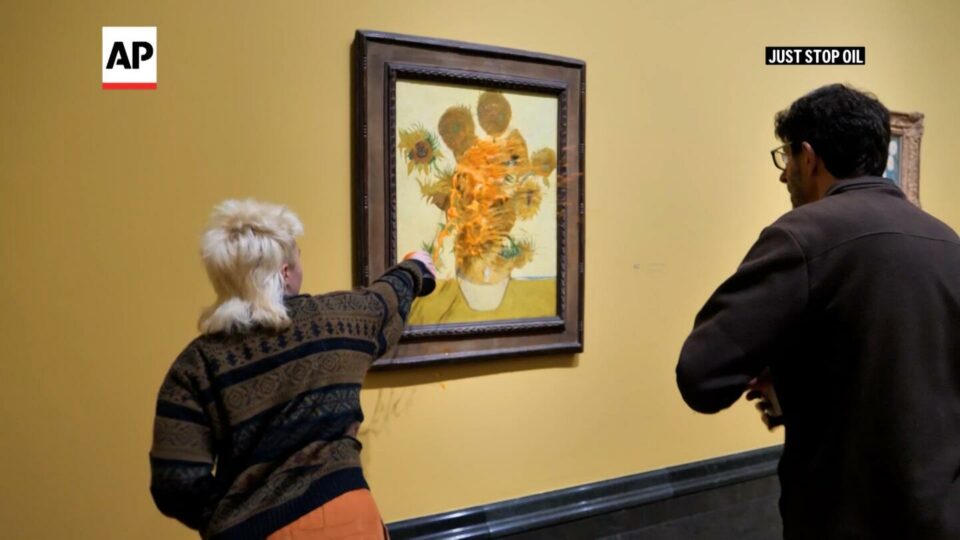People also asked:
In a bold and controversial move, climate activists made a powerful statement at London’s National Gallery by tossing red paint and soup at Van Gogh’s famous painting “Sunflowers.” The act, which has sparked heated debates and divided opinions, was carried out in protest of the gallery’s ties to the oil industry and its perceived complicity in contributing to climate change.
The incident took place during a private viewing of the exhibition “Reflections: Van Eyck and the Pre-Raphaelites,” where the 1888 masterpiece “Sunflowers” was on display. The activists, part of the organization “BP or not BP?” targeted the painting, citing the National Gallery’s long-standing sponsorship deals with oil companies as a clear conflict of interest.
This act of defiance by the climate activists has sparked a wider conversation about the role of cultural institutions in promoting environmental sustainability and ethical partnerships. The intersection of art, activism, and environmentalism has brought to light the urgency of addressing climate change and holding institutions accountable for their associations with industries that are detrimental to the planet.
The incident at the National Gallery raises pertinent questions about the impact of corporate sponsorship on the arts and the responsibility of cultural institutions to align their values with those of the environmental movement. Here, we delve into the details of the soup tossing incident, its implications, and the broader discussions it has ignited.
The Protest at the National Gallery: What Happened?
On March 28, 2022, a group of climate activists entered the National Gallery and staged a symbolic protest by tossing red paint and soup at the iconic “Sunflowers” painting by Vincent Van Gogh. Clad in clothing adorned with sunflower motifs, the activists made a deliberate statement by defacing the artwork to draw attention to the gallery’s financial ties with BP, an oil and gas company.
The activists emphasized that their action was aimed not at the artist or the painting itself, but rather at the institution and its complicity in promoting the interests of the fossil fuel industry. According to the group, the National Gallery’s acceptance of sponsorships from oil companies like BP contradicts the themes of environmental conservation and preservation often depicted in works of art.
The National Gallery’s Response
Following the incident, the National Gallery released a statement expressing “great sadness” over the defacement of the painting and condemning the activists’ actions as an “attack on the shared cultural heritage of all people.” The gallery reiterated its commitment to freedom of expression and open dialogue but stood firm in its defense of maintaining diverse funding sources to support its operations and public programs.
In the
The National Gallery in London was once again the target of climate activists, as they threw soup over Vincent van Gogh’s famous painting “Sunflowers.” This shocking act of protest was carried out by three members of the Just Stop Oil organization. The protesters were inspired to take this action after two British climate activists were convicted for dousing van Gogh’s masterpiece with tomato soup in 2022, causing significant damage to the iconic work of art.
This unprecedented display of activism has sparked widespread debate and controversy. While some view it as a powerful statement against environmental destruction, others condemn it as an unacceptable violation of cultural heritage.
The incident has raised questions about the intersection of art and activism. While many believe that art should be preserved and protected at all costs, others argue that urgent global issues such as climate change warrant extreme measures.
In light of this event, it is essential to consider the broader implications for both the art world and the environmental movement. The clash between these two spheres forces us to reevaluate our priorities and consider how we can address pressing issues without compromising our cultural heritage.
It is worth noting that acts like these have real consequences beyond their immediate impact on individual works of art. They ignite challenging conversations about ethics, responsibility, and the role of institutions in addressing public concerns.
Ultimately, this incident serves as a stark reminder that meaningful change often comes with difficult choices and unforeseen challenges. As we navigate an increasingly complex world, finding common ground between seemingly conflicting priorities will become crucial for progress on both artistic preservation and environmental conservation initiatives.


